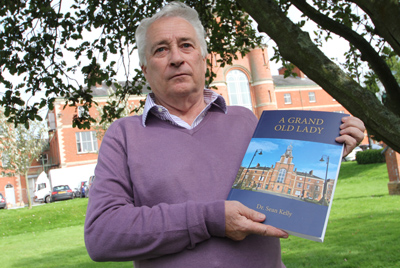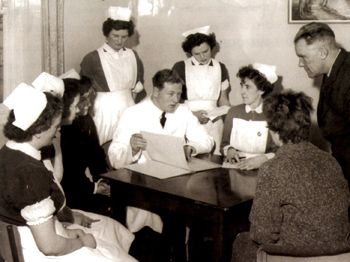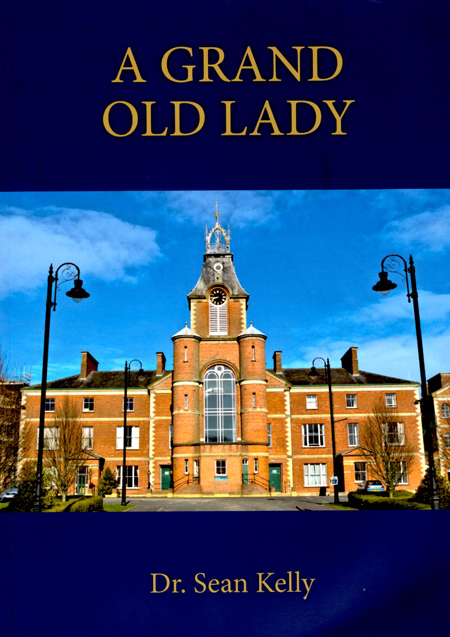‘A Grand Old Lady’ is an appropriate title for a fascinating 200-page book on the history of the Downshire Hospital in Downpatrick.

Written by Dr Sean Kelly who started his nursing training in the Downshire Hospital in 1964, this work comes at a time when the famous mental health institution had finally ran its course.
Sean Kelly began his medical profession as a mental health nurse and moved over to education to teach at Queen’s University. He said: “At its peak the Downshire had 1200 patients and hundreds of staff. It was certainly the biggest employer in the area. I have been comitted to the Downshire my whole working life almost and I felt it appropriate to try and piece together its long history. It has made a huge contribution to social and business life in the Downpatrick area, and generations of families have worked there.”
In the introduction to the book, Hugh McCaughey, South Eastern HSC Trust Chief Executive who started work at Downshire as a management trainee, said: “It was a unique experience for me and little did I know at the time that I was witnessing the transformation of Mental Health that would eventually leave the large Victorian institution empty of patients…
“Best practice tells us that this way of working promotes the best chance of recovery. Our clinical staff, the doctors, nurses,social workers, occupational therapists and psychologists practice in many different settings to promote independence, human rights and citizenship, the cornerstones of the Bamford Review.”
Sean added: “There has never been a really exhaustive history completed on the Downshire so I have put ‘A Grand Old Lady’ together to try and bridge the gap. Even after the long research there are still many items of information popping up and these will be recorded to add to the information we have already collected. I interviewed staff who had worked in the Downshire Hospital going back to the 1940’s.

“I spent many hours looking through the annual reports. Most of them are complete. I spoke to many of the former staff going back to the sixties, and I have collected much anecdotal information. I gleaned local reports, read old letters, and uncovered many old photographs. I was amazed at the great sense of camaraderie there was between the staff and the patients. The records show that as far back as the 1870’s, staff took some patients home with them for dinners and this proved to be a very supportive function for the patients. There was generally a great sense of community and togetherness.
“Many of the patients were incarcerated because of mental health and learning or behavioiural issues. The Downshire opened in October 1869, and from the beginning they tried to aim at being sustainable by growing their own food, keeping hens for eggs, baking their own food and even making their own clothes. Initially is was opened as the County Down Lunatic Assylum and ended up as the Downshire Hospital.
“There was one man who was admitted as a child and he remained there for 74 years only dying recently. His case showed the positive side of the hospital… he has held down a job there and participated in the sports activities.
“Sports were seen as important and Jimmy Murphy set up a programme which involved entertainments, and the Great Hall in the Downshire began its association with musicals, plays and performances. The Downshire Pipe Band started up in the 1960’s.”
Sean Kelly explained that some staff lived in the Downshire in secure accomodation often quite close to the patients right up to the 1950’s. Many saw a job in the Downshire as for life. He added that there were services conducted by the different churches for the patients.
He said: “A group of us like-minded former staff members have come together and formed the Downshire Hospital Heritage Committee. We have since identified a room in the Downshire and we hope to turn it into a sort of heritage centre in due course. Since my retirement I have collected a lot of material. The South Eastern HSC Trust have been very helpful.
“Mental health care has come a long way since the earlier days at the Downshire where they practiced ECT, hydrotherapy, pre-frontal labotamy and drug based therapies. It was all quite drastic by today’s standards. But I can only remember a straight jacket being used on a very small number of occasions.”
Sean added: “The book reveals the many sides of life at the Downshire over its years, and there is even a chapter on strange happenings and ghostly presences which is very interesting.”


























